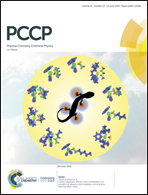Tetrel bonding interaction: an analysis with the block-localized wavefunction (BLW) approach†
Abstract
In this study, fifty-one iconic tetrel bonding complexes were studied using the block localized wave function (BLW) method which can derive the self-consistent wavefunction for an electron-localized (diabatic) state where charge transfer is strictly deactivated. Energy decompositions based on the BLW method (BLW-ED in short) show that the frozen energy, which is mostly composed of the Pauli repulsion and electrostatic components, plays the dominating role in thirty-one out of these fifty-one systems. A further quantitative study of electrostatic potential (ESP) was carried out by analyzing the variation of ESP along the binding direction for each monomer. In general, a Lewis base with the stronger ESP leads to higher stabilizing frozen and polarization energies. In addition, the relative strengths for complexes constructed with different carbon group elements are also examined qualitatively using the ESP model. The positive contribution of the charge transfer interaction is confirmed by both the BLW-ED results and the weakening of bond strengths after the charge transfer interaction is disabled. Finally, by replacing all atoms of a monomer with σ-holes (Lewis acid) with empirical point charges, attractive electrostatic interaction was observed in all cases, providing us a simple electrostatic explanation for the tetrel bonding, though the anisotropy of electron density associated with the σ-holes is unconsidered.



 Please wait while we load your content...
Please wait while we load your content...